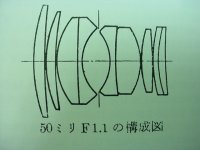Why Schneider-Kreuznach didn't make it 1930?
Probably cost. A.W. Tronnier's son (who is over 80) wrote me his father as a young engineer was forced by his boss (after successfully launching the f/2 Xenon) to develop a f/1.5 lens with only
6 elements, which (no wonder) turned out as bad performer and quite never sold. Maybe it was prior, or after this patent.
In summary Schneider-K. was probably the most innovative optical firm of the 1930's. Remember they licensed Leitz to build their 7-elements f/1.5 Xenon (Summarit after the war)
Technically there were at least
two 'cons in the 30's: No coating technique and not available high-refractive glass(three of the Nikkor-N lenses were made of glass with an refractive index=1.71, whereas Tronnier couldn't use higher glass than with 1.6525)
..Whereas in the 50's there was high refractive Lanthan glass available in general. So the real question is, why didn't made it in the
1950's ??
Not Schneider-Kr. who hadn't lens designers skilled enough after Tronnier had changed to Voigtlaender (where he designed the Apo-Lanthar; of course build with Lanthan-glass 1950)
What happend later is well-known: Zeiss-Ikon overtook Voigtlaender and throttled their development in favor of their own Contarex system, and lenses.
For the next 15 years they continued telling their customers, especially in Germany - how fast a lens had to be and how it should look like - until they had enough and bought Japanese cameras.
Tronnier even developed an 0.87/76mm lens with excellent correction and capable of 75l/mm wide open as a freelancer
for an American company looking like this:





